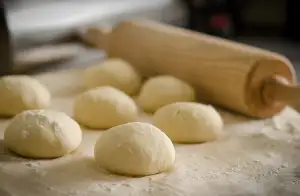Deliciously Gluten-Free: Master the Perfect Pizza Dough Recipe

Pizza is a beloved dish enjoyed by people all over the world. However, for those with gluten sensitivities or celiac disease, traditional pizza dough can be off-limits. But fear not! With the rise in popularity of gluten-free diets, there are now delicious alternatives available. In this article, we will explore the world of gluten-free pizza dough and learn how to master the perfect recipe at home. Get ready to savor the flavors of a mouthwatering gluten-free pizza that will leave you wanting more!
Understanding Gluten and its Effects on Health
Gluten is a protein found in wheat, barley, and rye. For individuals with celiac disease or gluten sensitivity, consuming gluten can lead to various health issues. Celiac disease is an autoimmune disorder where the body's immune system attacks the small intestine when gluten is ingested. This can cause damage to the intestinal lining and result in nutrient deficiencies.
Even for those without celiac disease, gluten sensitivity can cause uncomfortable symptoms like bloating, abdominal pain, and fatigue. By eliminating gluten from their diet, individuals can experience relief from these symptoms.
Moreover, research suggests that a gluten-free diet may benefit individuals with certain conditions such as irritable bowel syndrome (IBS) and inflammatory bowel disease (IBD). It has been found that reducing or eliminating gluten intake can alleviate gastrointestinal symptoms in some cases.
Understanding the effects of gluten on health is crucial for making informed dietary choices. By opting for a gluten-free pizza dough recipe, individuals can enjoy delicious pizza while avoiding potential health complications associated with gluten consumption.
Benefits of Gluten-Free Pizza Dough
There are several benefits to using gluten-free pizza dough. Firstly, it caters to individuals with gluten intolerance or celiac disease, allowing them to enjoy a delicious pizza without any adverse effects on their health. Secondly, gluten-free pizza dough is often made with alternative flours such as rice flour or almond flour, which can be more nutrient-dense than traditional wheat flour. This means that gluten-free pizza can provide a healthier option for those looking to watch their calorie intake or improve their overall nutrition. Lastly, gluten-free pizza dough offers a unique and flavorful twist to traditional pizza, allowing for a diverse range of toppings and flavors that can be enjoyed by everyone, regardless of dietary restrictions. So whether you have a gluten sensitivity or simply want to try something new and delicious, gluten-free pizza dough is definitely worth exploring!
Ingredients for Gluten-Free Pizza Dough Recipe
To make the perfect gluten-free pizza dough, you will need a few key ingredients. Here's what you'll need:
1. Gluten-Free Flour Blend: Look for a high-quality gluten-free flour blend that is specifically designed for baking. This will serve as the base of your dough.
2. Xanthan Gum: Xanthan gum is a crucial ingredient in gluten-free baking as it helps bind the dough together and give it elasticity.
3. Yeast: You'll need active dry yeast to help the dough rise and create a light and airy texture.
4. Warm Water: The water should be warm, but not too hot, as this will activate the yeast.
5. Olive Oil: A small amount of olive oil adds richness and flavor to the dough.
6. Salt: Don't forget to add a pinch of salt to enhance the overall taste of your pizza crust.
These simple ingredients work together to create a gluten-free pizza dough that is both delicious and easy to work with. With these basic pantry staples, you'll be well on your way to making homemade gluten-free pizza that rivals any pizzeria!
Step-by-Step Instructions for Making Gluten-Free Pizza Dough
1. In a large mixing bowl, combine 2 cups of gluten-free flour blend, 1 teaspoon of xanthan gum, and 1 teaspoon of salt.
2. Create a well in the center of the dry ingredients and add 2 tablespoons of olive oil and 1 cup of warm water.
3. Gradually mix the wet and dry ingredients together until a sticky dough forms.
4. Dust a clean surface with gluten-free flour and transfer the dough onto it.
5. Knead the dough for about 5 minutes until it becomes smooth and elastic.
6. Place the dough back into the mixing bowl, cover it with a damp cloth, and let it rise in a warm place for about an hour.
7. Preheat your oven to 450°F (230°C) and grease a pizza pan or baking sheet with olive oil.
8. Once the dough has risen, remove it from the bowl and place it on a floured surface again.
9. Roll out the dough into your desired pizza shape, making sure it's evenly thin throughout.
10. Transfer the rolled-out dough onto the greased pan or baking sheet.
11. Add your favorite gluten-free pizza sauce and toppings on top of the dough.
12. Bake in the preheated oven for approximately 15-20 minutes or until the crust is golden brown and crispy.
13. Remove from the oven, let it cool slightly, then slice and serve your delicious homemade gluten-free pizza!
Tips and Tricks for Perfect Gluten-Free Pizza Dough
1. Use a combination of gluten-free flours: Experiment with different combinations of gluten-free flours like rice flour, almond flour, tapioca flour, and potato starch to achieve the perfect texture and flavor in your pizza dough.
2. Add xanthan gum or psyllium husk powder: These ingredients help bind the dough together and give it elasticity, which is often lacking in gluten-free doughs. Start with small amounts and adjust according to your preference.
3. Let the dough rest: After mixing the ingredients, let the dough rest for at least 30 minutes. This allows the flours to fully hydrate and results in a more tender crust.
4. Roll out the dough between parchment paper: Gluten-free dough can be sticky and difficult to handle. Rolling it out between two sheets of parchment paper prevents sticking and makes it easier to transfer onto a baking sheet or pizza stone.
5. Pre-bake the crust: To ensure a crispy crust, pre-bake the pizza dough for about 10 minutes before adding toppings. This helps prevent a soggy bottom.
6. Don't overload with toppings: Gluten-free pizza crusts are generally more delicate than traditional ones, so avoid piling on too many heavy or wet toppings that could weigh down the crust.
7. Experiment with alternative cheeses: If you're lactose intolerant or following a dairy-free diet, try using dairy-free cheese alternatives like cashew cheese or vegan mozzarella to top your gluten-free pizza.
8. Use high heat for baking: To achieve a nicely browned crust, bake your gluten-free pizza at a high temperature (around 450°F/230°C) for a shorter amount of time rather than at lower heat for longer.
By following these tips and tricks, you'll be able to master the art of making perfect gluten-free pizza dough that is deliciously crisp, flavorful, and satisfying. Enjoy your homemade gluten-free pizza with confidence!
Baking and Topping Suggestions for Gluten-Free Pizza
Once you have mastered the art of making gluten-free pizza dough, it's time to explore the world of baking and topping options. The great thing about gluten-free pizza is that you can get creative with your toppings while still enjoying a delicious and healthy meal.
When it comes to baking your gluten-free pizza, preheating your oven is crucial. Set it to the highest temperature possible to ensure a crispy crust. A pizza stone or baking sheet lined with parchment paper works best for even heat distribution.
Now let's talk toppings! Traditional tomato sauce is always a classic choice, but feel free to experiment with different sauces like pesto or white sauce made from cashews or cauliflower. For added flavor, sprinkle some dried herbs like oregano or basil on top.
Cheese lovers can opt for dairy-free alternatives like vegan mozzarella or goat cheese. If you prefer a lighter option, try using sliced fresh tomatoes or roasted vegetables as a base instead.
To add some protein, consider topping your pizza with grilled chicken, shrimp, or tofu. Don't forget the veggies! Bell peppers, onions, mushrooms, and olives are all excellent choices for adding color and texture.
For those who enjoy a bit of heat, sprinkle some red pepper flakes or drizzle hot sauce over your pizza before baking. And if you're feeling adventurous, try experimenting with unique flavors like caramelized onions and balsamic glaze or figs and prosciutto.
Remember to keep an eye on your pizza while it bakes – gluten-free crusts tend to cook faster than traditional ones. Once the edges are golden brown and the cheese has melted to perfection, it's time to take it out of the oven.
Whether you're hosting a dinner party or simply enjoying a cozy night in, these baking and topping suggestions will help elevate your gluten-free pizza experience. So go ahead and unleash your creativity in the kitchen – and savor every delicious bite of your homemade gluten-free pizza masterpiece.
With the perfect gluten-free pizza dough recipe in your arsenal, you can now indulge in delicious homemade pizza without worrying about gluten. By understanding the effects of gluten on health and opting for a gluten-free alternative, you are taking a step towards a healthier lifestyle.
Experiment with different toppings and flavors to create your own signature gluten-free pizza. Whether it's classic Margherita or loaded with vegetables and cheese, the possibilities are endless. Don't forget to explore various baking techniques to achieve that crispy yet chewy crust.
Invite friends and family over for a pizza night and impress them with your culinary skills. They won't even believe it's gluten-free! So go ahead, savor the flavors of life by mastering the art of making delicious gluten-free pizza at home.
Published: 28. 11. 2023
Category: Food



